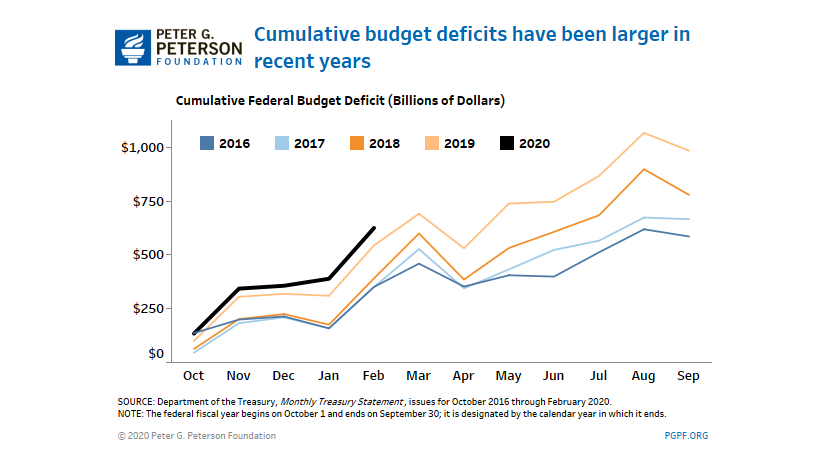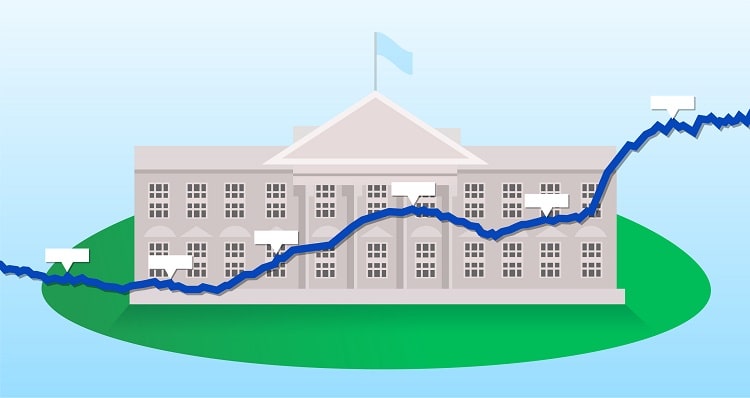Two items to remember;
1) The POTUS can recommend a Federal Budget, but Congress actually makes the budget and then the POTUS can either accept and sign-off, or decline and send back to Congress. Declining to accept and sign-off can result in a "government shutdown", which produces public negative feedback, and some economic repercussions. The last Budget Congress presented to Trump was way larger than he proposed/wanted, but under duress he signed-off on it.
...
Government shutdowns in the United States occur when there is a failure to enact
funding legislation to finance the government for its next fiscal year or a temporary funding measure. Ever since a 1980 interpretation of the 1884
Antideficiency Act, a "lapse of appropriation" due to a political impasse on proposed appropriation bills requires that the
US federal government curtail agency activities and services, close down non-essential operations,
furlough non-essential workers, and only retain essential employees in departments covering the safety of human life or protection of property.
[1] Voluntary services may only be accepted when required for the safety of life or property.
[1] Shutdowns can also occur within and disrupt
state,
territorial, and local levels of government.
Since the enactment of the US government's current budget and appropriations process in 1976, there have been a total of 22 funding gaps in the federal budget, ten of which have led to federal employees being furloughed. Prior to 1980, funding gaps did not lead to government shutdowns, until Attorney General
Benjamin Civiletti issued a legal opinion requiring the government to be shut down when a funding gap occurs.
[2] This opinion was not consistently adhered to through the 1980s, but since 1990 all funding gaps lasting longer than a few hours have led to a shutdown.
Some of the most significant shutdowns in U.S. history have included the
21-day shutdown of 1995–1996 during the
Bill Clinton administration over opposition to major spending cuts; the
16-day shutdown in 2013 during the
Barack Obama administration caused by a dispute over implementation of the
Affordable Care Act (ACA);
[3] and the
35-day shutdown of 2018-2019 during the
Donald Trump administration, the longest shutdown in US history,
[4] caused by a dispute over the funding amount for an
expansion of the U.S.–Mexico border barrier.
[5][6]
Shutdowns cause the disruption of government services and programs, including the closure of national parks and institutions (in particular, due to shortages of federal employees). A major loss of government revenue comes from lost labor from furloughed employees who are still paid, as well as loss of fees that would have been paid during the shutdown. Shutdowns also cause a significant reduction in economic growth (depending on the length of the shutdown). During the 2013 shutdown,
Standard & Poor's, the financial ratings agency, stated on October 16 that the shutdown had "to date taken $24 billion out of the economy", and "shaved at least 0.6 percent off annualized fourth-quarter 2013 GDP growth".
[7]
...
en.wikipedia.org
See also;
Government Shutdowns in 1995, 2013, 2018, and 2019 Explained
A shutdown occurs when Congress can't agree on a budget. The longest U.S. shutdown began on Dec. 21, 2018. Learn details about previous times the government has shutdown.
www.thebalance.com
~~~~~~~~~~~~~~~~~~~
2) Federal Debt in dollars alone is not the gauge. Inflation over time provides a relativity factor to consider. For example, this on the 1980 Dollar versus the 2021 dollar;
...
Value of $1 from 1980 to 2021
$1 in 1980 is equivalent in purchasing power to about $3.33 today, an increase of $2.33 over 41 years. The dollar had an average inflation rate of 2.98% per year between 1980 and today, producing a cumulative price increase of 232.90%.
This means that today's prices are 3.33 times higher than average prices since 1980, according to the Bureau of Labor Statistics consumer price index. A dollar today only buys 30.03% of what it could buy back then.
The 1980 inflation rate was 13.50%. The current year-over-year inflation rate (2020 to 2021) is now 5.39%
1. If this number holds, $1 today will be equivalent in buying power to $1.05 next year. The
current inflation rate page gives more detail on the latest inflation rates.
...
The 2.98% inflation rate means $1 in 1980 is equivalent to $3.33 today. This inflation calculator uses the official US consumer price index published by the Department of Labor.
www.in2013dollars.com
~~~~~~~~~~~~~~~


/what-is-a-government-shutdown-3305683-final2-41d23fa1c3674cd98a5fa16c87e53d18.png)



